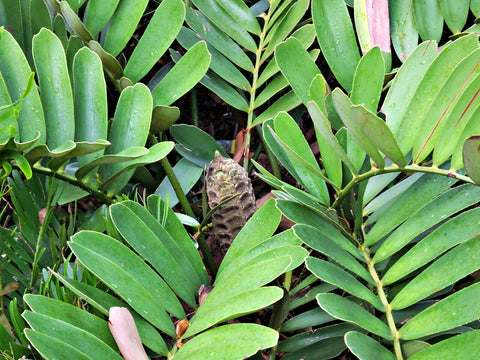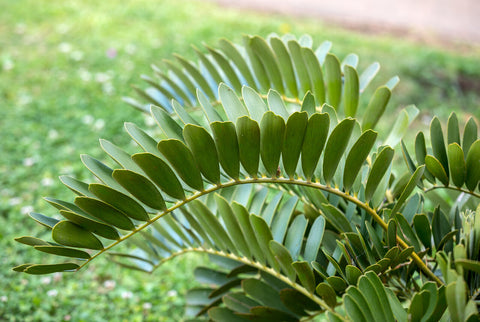Cardboard Palm: Growing & Care Guide

Last updated: Nov 10 2023

The first time you see a Cardboard Palm, it captures your imagination because you’ve never seen anything like it! The leaves look like a cross between a fern and a palm tree, but the leaflets are rigid and leathery, like cardboard (where it gets its common name). It’s easy to picture it growing in prehistoric environments next to dinosaurs. As exotic as it is, the Cardboard Palm couldn’t be any easier to grow as an interior plant and makes for a stunning piece of living art.
Cardboard Palm Care
Location
The Cardboard Palm can be grown outdoors in zones 9-11 and is surprisingly resilient in a variety of conditions, rarely dropping leaves and not minding salty soils or sea spray. Avoid planting the Cardboard Palm any low spots of the yard that are prone to standing water.
For colder growing zones grow your Cardboard Palm in a container where it can happily be outdoors before the temperatures go below 50F. The Cardboard Palm does well with low humidity, making it a great house plant year-round. When finding the ideal spot indoors for your Cardboard Palm, make sure to look around and keep your pot away from vents, fireplaces, or heaters.
Lighting
Outdoor or patio grown plants should be in bright but indirect light for 6-8 hours per day. Choose a location that has partial sun (around 6-8 hours) daily. The Cardboard Palm can do well in full sun but might struggle with the intensity of full afternoon sun, so consider planting it on the Eastern side of your house to harness the gentler morning sunlight.
Indoors, your Cardboard Palm will thrive in your sunniest window. This is often a southern facing window. Rotate the pot regularly to maintain a balanced shape. To transition it indoors for the winter, start moving the plant into indirect light while it’s outside.
Watering
The Cardboard Palm's trunk stores water to use during droughts, so they're sensitive to overwatering. Always water at the base of the plant, keeping the water away from the leaves. Let the soil dry completely between waterings if planting in a container. If you are prone to overwatering your plants, a moisture meter is worth the small investment because it eliminates the guesswork. Water less in the winter months as the plant isn’t actively growing and therefore will not take up as much water. Make sure no water is ever left standing around the base of your plant or in the saucer.
Soil
While the Cardboard Palm can handle a variety of soils, it prefers well-draining soil that has a slightly acidic pH of 6.0. As added insurance for good drainage, you can add some bark chips or orchid mix to your native soil or container mix. A succulent or cactus mix is also a good choice as it drains quickly.
Fertilizing
New plants don’t need fertilizing for a few months, they already have some fertilizer in their soil. Use a slow release fertilizer at first to avoid fertilizer burn. Then, use a balanced fertilizer once a month during the Cardboard Palm’s growing period, which is March to June. Because the plant goes dormant in the winter, there's no need to fertilize during this time.
Planting and Container Tips
- Select a pot slightly larger than the root ball with excellent drainage. We highly recommend that you add additional drainage holes or pick a container made of a porous material like unglazed terracotta.
- Because the Cardboard Palm doesn’t like to have its roots disturbed, do not repot it often but wait until it’s root bound, where the roots are circling or escaping the bottom of the pot.
- Repot your Cardboard Palm in the springtime and choose a container that is around 3-4 inches larger in diameter than the current container to allow room for growth.
- It's common for indoor or container grown Cardboard Palms to not grow to the size of ground planted ones. Expect indoor Cardboard Palms to grow to a size of 3’ x 3’ and outdoors ones to be around 6’ x 6’.
Pruning
Pruning of your Cardboard Palm is hardly needed. Only remove any dead or damaged parts of the leaves. If you wish to keep your plant smaller, grow it in a container. You can also prune any offshoots to keep it on the smaller side, but avoid trimming the Cardboard Palm as it will distort its natural shape.

Troubleshooting
Cardboard Palms rarely have problems with disease and pests. When the Cardboard Palm is grown indoors, its proximity to other plants can make it vulnerable to the 3 main pests of house plants: Spider mites, mealybugs, and possibly scale. The best insurance with new plants is to isolate them for a few weeks while watching for pests. Neem Oil Spray is an effective treatment for pests, as is rubbing alcohol on a cotton ball to wipe away any visible pests you may see.
If the leaf tips of your Cardboard Palm start turning brown, it may indicate that the plant needs more humidity. You can add a humidifier or pebble tray to increase humidity levels. A sign that more light is needed will be yellowing leaves and leaf drop. For more help on troubleshooting your Cardboard Palm issues, follow this visual guide or reach out to chat with a Plant Expert.
Growing Tips
- Cardboard Palms are able to live 120 years with very, very slow growth. The growth rate picks up when the trunk develops. Letting Cardboard Palms spend their summers on the patio will also speed up their growth along with proper nutrition and care.
- To propagate new Cardboard Palm plants, the best method will be to pull offshoots from the main plant. Cardboard Palms do not flower but can produce a lot of seeds in their cones. However you will need a male and female Cardboard Palm to achieve this as well as patience, as they have a limited viability period and propagation is very slow.
- Keep seeds and all parts of the plant away from curious pets and little hands because all parts of the Cardboard Palm are very toxic.
- The Cardboard Palm produces little spines along the stems. They are not really hurtful but are something to be aware of.
- New leaves are a lighter greenish yellow color.
Suggested Uses
In landscaping, the Cardboard Palm can provide a focal point. It’s outstanding in xeriscaping design and containers alike. The foliage of the Cardboard Palm provides a great backdrop for colorful flowers while providing texture and depth to your space. Try planting several Cardboard Palms in a row to form a hedge or border or establish privacy, as they can grow 6 to 8 feet tall. As a potted plant, the Cardboard Palm is a showstopper. It pairs well with spider plants, crotons, and birkin philodendrons. And, after several years, you can take advantage of its rough, round base and train it as a bonsai. Another cycad you may like is the Sago Palm.
Native Range
The Cardboard Palm is native to coastal mountains and sandy cliffs in the Yucatan peninsula in the Veracruz state of Mexico. There it grows in full sun or shade and tolerates a variety of well-drained soils. Cardboard Palms prefer low to average humidity, making them perfect as house plants. The secret to cycads' survival and long life lies inside this root structure that houses bacteria in a win-win relationship.

History
The Cardboard Palm, Zamia furfuracea, may resemble a palm or a fern, but there’s no relation to either of these plants. It’s actually a type of plant called a cycad. Cycads have a long history dating back to 280 million years ago, so it’s no surprise that there are fossilized plant remains of cycads right alongside dinosaur fossils! Fast forward to present day, and the Cardboard Palm has been enjoyed as a houseplant since 1842 when botanical conservatories took interest.
In Love with the Cardboard Palm?
Enjoy the beauty of the Cardboard Palm in and around your home and add to your collection with these similar plants:
- Sago Palm (actually a cycad!)
- Fishtail Palm
- Lady Palm
- Ficus Tineke
For an even more tropical look in your landscape, compare and contrast palms to complement your cycad.
Need more help with cycad or palm care? Check out our House Plant 101 Course, perfect for beginners or those who need a tune-up on everything house plants. For questions, concerns, and anything in-between, reach out directly to us and we will be happy to help.

Written by
Barbara Wilkat
Barbara's earlier careers as a graphic designer took her on travels throughout the Middle East and Southeast Asia, where she was able to see how people connected with plants and agriculture. After returning to school for an Associate Degree in Horticulture, she started her own landscape design and maintenance company.
Since then, she's worn different hats in the industry, from horticulturist to landscape designer. Her passion for interior plants exploded when she was able to work for Interior landscaping companies. And while she learns something new about plants everyday, she enjoys helping folks understand plant care.
























































































































































































































































